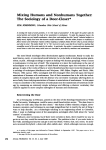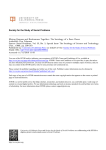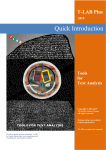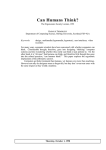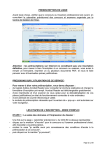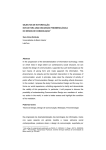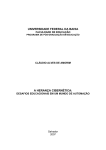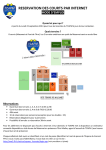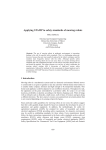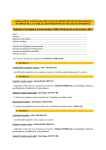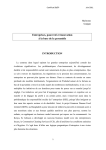Download 10 ``Where Are the Missing Masses? The Sociology of
Transcript
10 ‘‘Where Are the Missing Masses? The Sociology of a Few Mundane Artifacts’’ Bruno Latour One of the most popular and powerful ways of resolving the technological determinism/ social constructivism dichotomy in technology studies is the actor network approach. Those advocating the actor network approach agree with the social constructivist claim that sociotechnical systems are developed through negotiations between people, institutions, and organizations. But they make the additional interesting argument that artifacts are part of these negotiations as well. This is not to say that machines think like people do and decide how they will act, but their behavior or nature often has a comparable role. Actor network theorists argue that the material world pushes back on people because of its physical structure and design. People are free to interpret the precise meaning of an artifact, but they can’t simply tell an automobile engine that it should get 100 miles per gallon. The laws of nature and the capacities of a particular design limit the ways in which artifacts can be integrated into a sociotechnical system. In this chapter, one of the foremost contributors to the actor network approach, Bruno Latour, explores how artifacts can be deliberately designed to both replace human action and constrain and shape the actions of other humans. His study demonstrates how people can ‘‘act at a distance’’ through the technologies they create and implement and how, from a user’s perspective, a technology can appear to determine or compel certain actions. He argues that even technologies that are so commonplace that we don’t even think about them can shape the decisions we make, the effects our actions have, and the way we move through the world. Technologies play such an important role in mediating human relationships, Latour argues, that we cannot understand how societies work without an understanding of how technologies shape our everyday lives. Latour’s study of the relationship between producers, machines, and users demonstrates how certain values and political goals can be achieved through the construction and employment of technologies. Again, might not the glory of the machines consist in their being without this same boasted gift of language? ‘‘Silence,’’ it has been said by one writer, ‘‘is a virtue which render us agreeable to our fellow-creatures.’’ Samuel Butler (Erewhon, chap. 23) Early this morning, I was in a bad mood and decided to break a law and start my car without buckling my seat belt. My car usually does not want to start before I buckle the belt. It first flashes a red light ‘‘FASTEN YOUR SEAT BELT!,’’ then an alarm sounds; it is From Wiebe E. Bijker and John Law, eds., Shaping Technology/Building Society: Studies in Sociotechnical Change (Cambridge, Mass.: MIT Press, 1992), pp. 225–258. Reprinted with permission. 152 Bruno Latour so high pitched, so relentless, so repetitive, that I cannot stand it. After ten seconds I swear and put on the belt. This time, I stood the alarm for twenty seconds and then gave in. My mood had worsened quite a bit, but I was at peace with the law—at least with that law. I wished to break it, but I could not. Where is the morality? In me, a human driver, dominated by the mindless power of an artifact? Or in the artifact forcing me, a mindless human, to obey the law that I freely accepted when I get my driver’s license? Of course, I could have put on my seat belt before the light flashed and the alarm sounded, incorporating in my own self the good behavior that everyone— the car, the law, the police—expected of me. Or else, some devious engineer could have linked the engine ignition to an electric sensor in the seat belt, so that I could not even have started the car before having put it on. Where would the morality be in those two extreme cases? In the electric currents flowing in the machine between the switch and the sensor? Or in the electric currents flowing down my spine in the automatism of my routinized behavior? In both cases the result would be the same from an outside observer—say a watchful policeman: this assembly of a driver and a car obeys the law in such a way that it is impossible for a car to be at the same time moving AND to have the driver without the belt on. A law of the excluded middle has been built, rendering logically inconceivable as well as morally unbearable a driver without a seat belt. Not quite. Because I feel so irritated to be forced to behave well that I instruct my garage mechanics to unlink the switch and the sensor. The excluded middle is back in! There is at least one car that is both on the move and without a seat belt on its driver—mine. This was without counting on the cleverness of engineers. They now invent a seat belt that politely makes way for me when I open the door and then straps me as politely but very tightly when I close the door. Now there is no escape. The only way not to have the seat belt on is to leave the door wide open, which is rather dangerous at high speed. Exit the excluded middle. The program of action1 ‘‘IF a car is moving, THEN the driver has a seat belt’’ is enforced. It has become logically—no, it has become sociologically—impossible to drive without wearing the belt. I cannot be bad anymore. I, plus the car, plus the dozens of patented engineers, plus the police are making me be moral (figure 10.1). According to some physicists, there is not enough mass in the universe to balance the accounts that cosmologists make of it. They are looking everywhere for the ‘‘missing mass’’ that could add up to the nice expected total. It is the same with sociologists. They are constantly looking, somewhat desperately, for social links sturdy enough to tie all of us together or for moral laws that would be inflexible enough to make us behave properly. When adding up social ties, all does not balance. Soft humans and weak moralities are all sociologists can get. The society they try to recompose with bodies and norms constantly crumbles. Something is missing, something that should be strongly social and highly moral. Where can they find it? Everywhere, but they too often refuse to see it in spite of much new work in the sociology of artifacts.2 I expect sociologists to be much more fortunate than cosmologists, because they will soon discover their missing mass. To balance our accounts of society, we simply ‘‘Where Are the Missing Masses?’’ 153 Figure 10.1 The designers of the seat belt take on themselves and then shift back to the belt contradictory programs; the best should be lenient and firm, easy to put on and solidly fastened while ready to be unbuckled in a fraction of a second; it should be unobtrusive and strap in the whole body. The object does not reflect the social. It does more. It transcribes and displaces the contradictory interests of people and things. have to turn our exclusive attention away from humans and look also at nonhumans. Here they are, the hidden and despised social masses who make up our morality. They knock at the door of sociology, requesting a place in the accounts of society as stubbornly as the human masses did in the nineteenth century. What our ancestors, the founders of sociology, did a century ago to house the human masses in the fabric of social theory, we should do now to find a place in a new social theory for the nonhuman masses that beg us for understanding. Description of a Door I will start my inquiry by following a little script written by anonymous hands.3 On a freezing day in February, posted on the door of La Halle aux Cuirs at La Villette, in Paris, where Robert Fox’s group was trying to convince the French to take up social history of science, could be seen a small handwritten notice: ‘‘The Groom Is On Strike, For God’s Sake, Keep The Door Closed’’ (‘‘groom’’ is Frenglish for an automated door-closer or butler). This fusion of labor relations, religion, advertisement, and technique in one insignificant fact is exactly the sort of thing I want to describe4 in order to discover the missing masses of our society. As a technologist teaching in the School of Mines, an engineering institution, I want to challenge some of the assumptions sociologists often hold about the social context of machines. 154 Bruno Latour Walls are a nice invention, but if there were no holes in them there would be no way to get in or out—they would be mausoleums or tombs. The problem is that if you make holes in the walls, anything and anyone can get in and out (cows, visitors, dust, rats, noise—La Halle aux Cuirs is ten meters from the Paris ring road—and, worst of all, cold—La Halle aux Cuirs is far to the north of Paris). So architects invented this hybrid: a wall hole, often called a door, which although common enough has always struck me as a miracle of technology. The cleverness of the invention hinges upon the hingepin: instead of driving a hole through walls with a sledgehammer or a pick, you simply gently push the door (I am supposing here that the lock has not been invented—this would overcomplicate the already highly complex story of La Villette’s door); furthermore—and here is the real trick—once you have passed through the door, you do not have to find trowel and cement to rebuild the wall you have just destroyed: you simply push the door gently back (I ignore for now the added complication of the ‘‘pull’’ and ‘‘push’’ signs). So, to size up the work done by hinges, you simply have to imagine that every time you want to get in or out of the building you have to do the same work as a prisoner trying to escape or as a gangster trying to rob a bank, plus the work of those who rebuild either the prison’s or the bank’s walls. If you do not want to imagine people destroying walls and rebuilding them every time they wish to leave or enter a building, then imagine the work that would have to be done to keep inside or outside all the things and people that, left to themselves, would go the wrong way.5 As Maxwell never said, imagine his demon working without a door. Anything could escape from or penetrate into La Halle aux Cuirs, and soon there would be complete equilibrium between the depressing and noisy surrounding area and the inside of the building. Some technologists, including the present writer in Material Resistance, A Textbook (1984), have written that techniques are always involved when asymmetry or irreversibility are the goal; it might appear that doors are a striking counterexample because they maintain the wall hole in a reversible state; the allusion to Maxwell’s demon clearly shows, however, that such is not the case; the reversible door is the only way to trap irreversibly inside La Halle aux Cuirs a differential accumulation of warm historians, knowledge, and also, alas, a lot of paperwork; the hinged door allows a selection of what gets in and what gets out so as to locally increase order, or information. If you let the drafts get inside (these renowned ‘‘courants d’air’’ so dangerous to French health), the paper drafts may never get outside to the publishers. Now, draw two columns (if I am not allowed to give orders to the reader, then I offer it as a piece of strongly worded advice): in the right-hand column, list the work people would have to do if they had no door; in the left-hand column write down the gentle pushing (or pulling) they have to do to fulfill the same tasks. Compare the two columns: the enormous effort on the right is balanced by the small one on the left, and this is all thanks to hinges. I will define this transformation of a major effort into a minor one by the words displacement or translation or delegation or shifting;6 I will say that we have delegated (or translated or displaced or shifted down) to the hinge the ‘‘Where Are the Missing Masses?’’ 155 work of reversibly solving the wall-hole dilemma. Calling on Robert Fox, I do not have to do this work nor even think about it; it was delegated by the carpenter to a character, the hinge, which I will call a nonhuman. I simply enter La Halle aux Cuirs. As a more general descriptive rule, every time you want to know what a nonhuman does, simply imagine what other humans or other nonhumans would have to do were this character not present. This imaginary substitution exactly sizes up the role, or function, of this little character. Before going on, let me point out one of the side benefits of this table: in effect, we have drawn a scale where tiny efforts balance out mighty weights; the scale we drew reproduces the very leverage allowed by hinges. That the small be made stronger than the large is a very moral story indeed (think of David and Goliath); by the same token, it is also, since at least Archimedes’ days, a very good definition of a lever and of power: what is the minimum you need to hold and deploy astutely to produce the maximum effect. Am I alluding to machines or to Syracuse’s King? I don’t know, and it does not matter, because the King and Archimedes fused the two ‘‘minimaxes’’ into a single story told by Plutarch: the defense of Syracuse through levers and war machines.7 I contend that this reversal of forces is what sociologists should look at in order to understand the social construction of techniques, and not a hypothetical ‘‘social context’’ that they are not equipped to grasp. This little point having been made, let me go on with the story (we will understand later why I do not really need your permission to go on and why, nevertheless, you are free not to go on, although only relatively so). Delegation to Humans There is a problem with doors. Visitors push them to get in or pull on them to get out (or vice versa), but then the door remains open. That is, instead of the door you have a gaping hole in the wall through which, for instance, cold rushes in and heat rushes out. Of course, you could imagine that people living in the building or visiting the Centre d’Historie des Sciences et des Techniques would be a well-disciplined lot (after all, historians are meticulous people). They will learn to close the door behind them and retransform the momentary hole into a well-sealed wall. The problem is that discipline is not the main characteristic of La Villette’s people; also you might have mere sociologists visiting the building, or even pedagogues from the nearby Centre de Formation. Are they all going to be so well trained? Closing doors would appear to be a simple enough piece of know-how once hinges have been invented, but, considering the amount of work, innovations, sign-posts, and recriminations that go on endlessly everywhere to keep them closed (at least in northern regions), it seems to be rather poorly disseminated. This is where the age-old Mumfordian choice is offered to you: either to discipline the people or to substitute for the unreliable people another delegated human character whose only function is to open and close the door. This is called a groom or a porter (from the French word for door), or a gatekeeper, or a janitor, or a concierge, or 156 Bruno Latour a turnkey, or a jailer. The advantage is that you now have to discipline only one human and may safely leave the others to their erratic behavior. No matter who it is and where it comes from, the groom will always take care of the door. A nonhuman (the hinges) plus a human (the groom) have solved the wall-hole dilemma. Solved? Not quite. First of all, if La Halle aux Cuirs pays for a porter, they will have no money left to buy coffee or books, or to invite eminent foreigners to give lectures. If they give the poor little boy other duties besides that of porter, then he will not be present most of the time and the door will stay open. Even if they had money to keep him there, we are now faced with a problem that two hundred years of capitalism has not completely solved: how to discipline a youngster to reliably fulfill a boring and underpaid duty? Although there is now only one human to be disciplined instead of hundreds, the weak point of the tactic can be seen: if this one lad is unreliable, then the whole chain breaks down; if he falls asleep on the job or goes walkabout, there will be no appeal: the door will stay open (remember that locking it is no solution because this would turn it into a wall, and then providing everyone with the right key is a difficult task that would not ensure that key holders will lock it back). Of course, the porter may be punished. But disciplining a groom—Foucault notwithstanding—is an enormous and costly task that only large hotels can tackle, and then for other reasons that have nothing to do with keeping the door properly closed. If we compare the work of disciplining the groom with the work he substitutes for, according to the list defined above, we see that this delegated character has the opposite effect to that of the hinge: a simple task—forcing people to close the door—is now performed at an incredible cost; the minimum effect is obtained with maximum spending and discipline. We also notice, when drawing the two lists, an interesting difference: in the first relationship (hinges vis-à-vis the work of many people), you not only had a reversal of forces (the lever allows gentle manipulations to displace heavy weights) but also a modification of time schedule: once the hinges are in place, nothing more has to be done apart from maintenance (oiling them from time to time). In the second set of relations (groom’s work versus many people’s work), not only do you fail to reverse the forces but you also fail to modify the time schedule: nothing can be done to prevent the groom who has been reliable for two months from failing on the sixtysecond day; at this point it is not maintenance work that has to be done but the same work as on the first day—apart from the few habits that you might have been able to incorporate into his body. Although they appear to be two similar delegations, the first one is concentrated at the time of installation, whereas the other is continuous; more exactly, the first one creates clear-cut distinctions between production, installation, and maintenance, whereas in the other the distinction between training and keeping in operation is either fuzzy or nil. The first one evokes the past perfect (‘‘once hinges had been installed . . .’’), the second the present tense (‘‘when the groom is at his post . . .’’). There is a built-in inertia in the first that is largely lacking in the second. The first one is Newtonian, the second Aristotelian (which is simply a way of repeating that the first is nonhuman and the other human). A profound temporal shift takes place when nonhumans are appealed to; time is folded. ‘‘Where Are the Missing Masses?’’ 157 Delegation to Nonhumans It is at this point that you have a relatively new choice: either to discipline the people or to substitute for the unreliable humans a delegated nonhuman character whose only function is to open and close the door. This is called a door-closer or a groom (‘‘groom’’ is a French trademark that is now part of the common language). The advantage is that you now have to discipline only one nonhuman and may safely leave the others (bellboys included) to their erratic behavior. No matter who they are and where they come from—polite or rude, quick or slow, friends or foes—the nonhuman groom will always take care of the door in any weather and at any time of the day. A nonhuman (hinges) plus another nonhuman (groom) have solved the wall-hole dilemma. Solved? Well, not quite. Here comes the deskilling question so dear to social historians of technology: thousands of human grooms have been put on the dole by their nonhuman brethren. Have they been replaced? This depends on the kind of action that has been translated or delegated to them. In other words, when humans are displaced and deskilled, nonhumans have to be upgraded and reskilled. This is not an easy task, as we shall now see. We have all experienced having a door with a powerful spring mechanism slam in our faces. For sure, springs do the job of replacing grooms, but they play the role of a very rude, uneducated, and dumb porter who obviously prefers the wall version of the door to its hole version. They simply slam the door shut. The interesting thing with such impolite doors is this: if they slam shut so violently, it means that you, the visitor, have to be very quick in passing through and that you should not be at someone else’s heels, otherwise your nose will get shorter and bloody. An unskilled nonhuman groom thus presupposes a skilled human user. It is always a trade-off. I will call, after Madeleine Akrich’s paper (Akrich 1992), the behavior imposed back onto the human by nonhuman delegates prescription.8 Prescription is the moral and ethical dimension of mechanisms. In spite of the constant weeping of moralists, no human is as relentlessly moral as a machine, especially if it is (she is, he is, they are) as ‘‘user friendly’’ as my Macintosh computer. We have been able to delegate to nonhumans not only force as we have known it for centuries but also values, duties, and ethics. It is because of this morality that we, humans, behave so ethically, no matter how weak and wicked we feel we are. The sum of morality does not only remain stable but increases enormously with the population of nonhumans. It is at this time, funnily enough, that moralists who focus on isolated socialized humans despair of us—us meaning of course humans and their retinue of nonhumans. How can the prescriptions encoded in the mechanism be brought out in words? By replacing them by strings of sentences (often in the imperative) that are uttered (silently and continuously) by the mechanisms for the benefit of those who are mechanized: do this, do that, behave this way, don’t go that way, you may do so, be allowed to go there. Such sentences look very much like a programming language. This substitution of words for silence can be made in the analyst’s thought experiments, but also by instruction booklets, or explicitly, in any training session, through the voice 158 Bruno Latour of a demonstrator or instructor or teacher. The military are especially good at shouting them out through the mouthpiece of human instructors who delegate back to themselves the task of explaining, in the rifle’s name, the characteristics of the rifle’s ideal user. Another way of hearing what the machines silently did and said are the accidents. When the space shuttle exploded, thousands of pages of transcripts suddenly covered every detail of the silent machine, and hundreds of inspectors, members of congress, and engineers retrieved from NASA dozens of thousands of pages of drafts and orders. This description of a machine—whatever the means—retraces the steps made by the engineers to transform texts, drafts, and projects into things. The impression given to those who are obsessed by human behavior that there is a missing mass of morality is due to the fact that they do not follow this path that leads from text to things and from things to texts. They draw a strong distinction between these two worlds, whereas the job of engineers, instructors, project managers, and analysts is to continually cross this divide. Parts of a program of action may be delegated to a human, or to a nonhuman. The results of such distribution of competences9 between humans and nonhumans is that competent members of La Halle aux Cuirs will safely pass through the slamming door at a good distance from one another while visitors, unaware of the local cultural condition, will crowd through the door and get bloody noses. The nonhumans take over the selective attitudes of those who engineered them. To avoid this discrimination, inventors get back to their drawing board and try to imagine a nonhuman character that will not prescribe the same rare local cultural skills to its human users. A weak spring might appear to be a good solution. Such is not the case, because it would substitute for another type of very unskilled and undecided groom who is never sure about the door’s (or his own) status: is it a hole or a wall? Am I a closer or an opener? If it is both at once, you can forget about the heat. In computer parlance, a door is an exclusive OR, not an AND gate. I am a great fan of hinges, but I must confess that I admire hydraulic door closers much more, especially the old heavy copper-plated one that slowly closed the main door of our house in Aloxe-Corton. I am enchanted by the addition to the spring of a hydraulic piston, which easily draws up the energy of those who open the door, retains it, and then gives it back slowly with a subtle type of implacable firmness that one could expect from a well-trained butler. Especially clever is its way of extracting energy from each unwilling, unwitting passerby. My sociologist friends at the School of Mines call such a clever extraction an ‘‘obligatory passage point,’’ which is a very fitting name for a door. No matter what you feel, think, or do, you have to leave a bit of your energy, literally, at the door. This is as clever as a toll booth.10 This does not quite solve all of the problems, though. To be sure, the hydraulic door closer does not bang the noses of those unaware of local conditions, so its prescriptions may be said to be less restrictive, but it still leaves aside segments of human populations: neither my little nephews nor my grandmother could get in unaided because our groom needed the force of an able-bodied person to accumulate enough energy to close the door later. To use Langdon Winner’s classic motto (1980): Because of their ‘‘Where Are the Missing Masses?’’ 159 prescriptions, these doors discriminate against very little and very old persons. Also, if there is no way to keep them open for good, they discriminate against furniture removers and in general everyone with packages, which usually means, in our late capitalist society, working- or lower-middle-class employees. (Who, even among those from higher strata, has not been cornered by an automated butler when they had their hands full of packages?) There are solutions, though: the groom’s delegation may be written off (usually by blocking its arm) or, more prosaically, its delegated action may be opposed by a foot (salesman are said to be expert at this). The foot may in turn be delegated to a carpet or anything that keeps the butler in check (although I am always amazed by the number of objects that fail this trial of force and I have very often seen the door I just wedged open politely closing when I turned my back to it). Anthropomorphism As a technologist, I could claim that provided you put aside the work of installing the groom and maintaining it, and agree to ignore the few sectors of the population that are discriminated against, the hydraulic groom does its job well, closing the door behind you, firmly and slowly. It shows in its humble way how three rows of delegated nonhuman actants11 (hinges, springs, and hydraulic pistons) replace, 90 percent of the time, either an undisciplined bellboy who is never there when needed or, for the general public, the program instructions that have to do with remembering-to-close-thedoor-when-it-is-cold. The hinge plus the groom is the technologist’s dream of efficient action, at least until the sad day when I saw the note posted on La Villette’s door with which I started this meditation: ‘‘The groom is on strike.’’ So not only have we been able to delegate the act of closing the door from the human to the nonhuman, we have also been able to delegate the human lack of discipline (and maybe the union that goes with it). On strike . . .12 Fancy that! Nonhumans stopping work and claiming what? Pension payments? Time off? Landscaped offices? Yet it is no use being indignant, because it is very true that nonhumans are not so reliable that the irreversibility we would like to grant them is always complete. We did not want ever to have to think about this door again—apart from regularly scheduled routine maintenance (which is another way of saying that we did not have to bother about it)—and here we are, worrying again about how to keep the door closed and drafts outside. What is interesting in this note is the humor of attributing a human characteristic to a failure that is usually considered ‘‘purely technical.’’ This humor, however, is more profound than in the notice they could have posted: ‘‘The groom is not working.’’ I constantly talk with my computer, who answers back; I am sure you swear at your old car; we are constantly granting mysterious faculties to gremlins inside every conceivable home appliance, not to mention cracks in the concrete belt of our nuclear plants. Yet, this behavior is considered by sociologists as a scandalous breach of natural barriers. When you write that a groom is ‘‘on strike,’’ this is only seen as a ‘‘projection,’’ 160 Bruno Latour as they say, of a human behavior onto a nonhuman, cold, technical object, one by nature impervious to any feeling. This is anthropomorphism, which for them is a sin akin to zoophily but much worse. It is this sort of moralizing that is so irritating for technologists, because the automatic groom is already anthropomorphic through and through. It is well known that the French like etymology; well, here is another one: anthropos and morphos together mean either that which has human shape or that which gives shape to humans. The groom is indeed anthropomorphic, in three senses: first, it has been made by humans; second, it substitutes for the actions of people and is a delegate that permanently occupies the position of a human; and third, it shapes human action by prescribing back what sort of people should pass through the door. And yet some would forbid us to ascribe feelings to this thoroughly anthropomorphic creature, to delegate labor relations, to ‘‘project’’—that is, to translate—other human properties to the groom. What of those many other innovations that have endowed much more sophisticated doors with the ability to see you arrive in advance (electronic eyes), to ask for your identity (electronic passes), or to slam shut in case of danger? But anyway, who are sociologists to decide the real and final shape (morphos) of humans (anthropos)? To trace with confidence the boundary between what is a ‘‘real’’ delegation and what is a ‘‘mere’’ projection? To sort out forever and without due inquiry the three different kinds of anthropomorphism I listed above? Are we not shaped by nonhuman grooms, although I admit only a very little bit? Are they not our brethren? Do they not deserve consideration? With your self-serving and self-righteous social studies of technology, you always plead against machines and for deskilled workers—are you aware of your discriminatory biases? You discriminate between the human and the inhuman. I do not hold this bias (this one at least) and see only actors—some human, some nonhuman, some skilled, some unskilled—that exchange their properties. So the note posted on the door is accurate; it gives with humor an exact rendering of the groom’s behavior: it is not working, it is on strike (notice, that the word ‘‘strike’’ is a rationalization carried from the nonhuman repertoire to the human one, which proves again that the divide is untenable). Built-in Users and Authors The debates around anthropomorphism arise because we believe that there exist ‘‘humans’’ and ‘‘nonhumans,’’ without realizing that this attribution of roles and action is also a choice.13 The best way to understand this choice is to compare machines with texts, since the inscription of builders and users in a mechanism is very much the same as that of authors and readers in a story. In order to exemplify this point I have now to confess that I am not a technologist. I built in my article a made-up author, and I also invented possible readers whose reactions and beliefs I anticipated. Since the beginning I have many times used the ‘‘you’’ and even ‘‘you sociologists.’’ I even asked you to draw up a table, and I also asked your permission to go on with the story. In doing so, I built up an inscribed reader to whom I prescribed qualities and behavior, ‘‘Where Are the Missing Masses?’’ 161 as surely as a traffic light or a painting prepare a position for those looking at them. Did you underwrite or subscribe this definition of yourself? Or worse, is there any one at all to read this text and occupy the position prepared for the reader? This question is a source of constant difficulties for those who are unaware of the basics of semiotics or of technology. Nothing in a given scene can prevent the inscribed user or reader from behaving differently from what was expected (nothing, that is, until the next paragraph). The reader in the flesh may totally ignore my definition of him or her. The user of the traffic light may well cross on the red. Even visitors to La Halle aux Cuirs may never show up because it is too complicated to find the place, in spite of the fact that their behavior and trajectory have been perfectly anticipated by the groom. As for the computer user input, the cursor might flash forever without the user being there or knowing what to do. There might be an enormous gap between the prescribed user and the user-in-the-flesh, a difference as big as the one between the ‘‘I’’ of a novel and the novelist.14 It is exactly this difference that upset the authors of the anonymous appeal on which I comment. On other occasions, however, the gap between the two may be nil: the prescribed user is so well anticipated, so carefully nested inside the scenes, so exactly dovetailed, that it does what is expected.15 The problem with scenes is that they are usually well prepared for anticipating users or readers who are at close quarters. For instance, the groom is quite good in its anticipation that people will push the door open and give it the energy to reclose it. It is very bad at doing anything to help people arrive there. After fifty centimeters, it is helpless and cannot act, for example, on the maps spread around La Villette to explain where La Halle aux Cuirs is. Still, no scene is prepared without a preconceived idea of what sort of actors will come to occupy the prescribed positions. This is why I said that although you were free not to go on with this paper, you were only ‘‘relatively’’ so. Why? Because I know that, because you bought this book, you are hard-working, serious, English-speaking technologists or readers committed to understanding new development in the social studies of machines. So my injunction to ‘‘read the paper, you sociologist’’ is not very risky (but I would have taken no chance with a French audience, especially with a paper written in English). This way of counting on earlier distribution of skills to help narrow the gap between built-in users or readers and users- or readers-in-the-flesh is like a pre-inscription.16 The fascinating thing in text as well as in artifact is that they have to thoroughly organize the relation between what is inscribed in them and what can/could/should be pre-inscribed in the users. Each setup is surrounded by various arenas interrupted by different types of walls. A text, for instance, is clearly circumscribed17 —the dust cover, the title page, the hard back—but so is a computer—the plugs, the screen, the disk drive, the user’s input. What is nicely called ‘‘interface’’ allows any setup to be connected to another through so many carefully designed entry points. Sophisticated mechanisms build up a whole gradient of concentric circles around themselves. For instance, in most modern photocopy machines there are troubles that even rather incompetent users may solve themselves like ‘‘ADD PAPER;’’ but then there are trickier ones that require a bit of explanation: ‘‘ADD TONER. SEE MANUAL, PAGE 30.’’ This instruction 162 Bruno Latour might be backed up by homemade labels: ‘‘DON’T ADD THE TONER YOURSELF, CALL THE SECRETARY,’’ which limit still further the number of people able to troubleshoot. But then other more serious crises are addressed by labels like ‘‘CALL THE TECHNICAL STAFF AT THIS NUMBER,’’ while there are parts of the machine that are sealed off entirely with red labels such as ‘‘DO NOT OPEN — DANGER, HIGH VOLTAGE, HEAT’’ or ‘‘CALL THE POLICE.’’ Each of these messages addresses a different audience, from the widest (everyone with the rather largely disseminated competence of using photocopying machines) to the narrowest (the rare bird able to troubleshoot and who, of course, is never there).18 Circumscription only defines how a setup itself has built-in plugs and interfaces; as the name indicates, this tracing of circles, walls, and entry points inside the text or the machine does not prove that readers and users will obey. There is nothing sadder that an obsolete computer with all its nice interfaces, but no one on earth to plug them in. Drawing a side conclusion in passing, we can call sociologism the claim that, given the competence, pre-inscription, and circumscription of human users and authors, you can read out the scripts nonhuman actors have to play; and technologism the symmetric claim that, given the competence and pre-inscription of nonhuman actors, you can easily read out and deduce the behavior prescribed to authors and users. From now on, these two absurdities will, I hope, disappear from the scene, because the actors at any point may be human or nonhuman, and the displacement (or translation, or transcription) makes impossible the easy reading out of one repertoire and into the next. The bizarre idea that society might be made up of human relations is a mirror image of the other no less bizarre idea that techniques might be made up of nonhuman relations. We deal with characters, delegates, representatives, lieutenants (from the French ‘‘lieu’’ plus ‘‘tenant,’’ i.e., holding the place of, for, someone else)—some figurative, others nonfigurative; some human, others nonhuman; some competent, others incompetent. Do you want to cut through this rich diversity of delegates and artificially create two heaps of refuse, ‘‘society’’ on one side and ‘‘technology’’ on the other? That is your privilege, but I have a less bungled task in mind. A scene, a text, an automatism can do a lot of things to their prescribed users at the range—close or far—that is defined by the circumscription, but most of the effect finally ascribed19 to them depends on lines of other setups being aligned. For instance, the groom closes the door only if there are people reaching the Centre d’Histoire des Sciences; these people arrive in front of the door only if they have found maps (another delegate, with the built-in prescription I like most: ‘‘you are here’’ circled in red on the map) and only if there are roads leading under the Paris ring road to the Halle (which is a condition not always fullfilled); and of course people will start bothering about reading the maps, getting their feet muddy and pushing the door open only if they are convinced that the group is worth visiting (this is about the only condition in La Villette that is fulfilled). This gradient of aligned setups that endow actors with the pre-inscribed competences to find its users is very much like Waddington’s ‘‘chreod’’:20 people effortlessly flow through the door of La Halle aux Cuirs and the groom, hundreds of times a day, recloses the door—when it is not stuck. The result of such an alignment of setups21 is to decrease the number of occasions in which words are used; most of the actions are silent, familiar, incorporated (in human or in non- ‘‘Where Are the Missing Masses?’’ 163 human bodies)—making the analyst’s job so much harder. Even the classic debates about freedom, determination, predetermination, brute force, or efficient will—debates that are the twelfth-century version of seventeenth-century discussions on grace—will be slowly eroded. (Because you have reached this point, it means I was right in saying that you were not at all free to stop reading the paper: positioning myself cleverly along a chreod, and adding a few other tricks of my own, I led you here . . . or did I? May be you skipped most of it, maybe you did not understand a word of it, o you, undisciplined readers.) Figurative and Nonfigurative Characters Most sociologists are violently upset by this crossing of the sacred barrier that separate human from nonhumans, because they confuse this divide with another one between figurative and nonfigurative actors. If I say that Hamlet is the figuration of ‘‘depression among the aristocratic class,’’ I move from a personal figure to a less personal one— that is, class. If I say that Hamlet stands for doom and gloom, I use less figurative entities, and if I claim that he represents western civilization, I use nonfigurative abstractions. Still, they all are equally actors, that is, entities that do things, either in Shakespeare’s artful plays or in the commentators’ more tedious tomes. The choice of granting actors figurativity or not is left entirely to the authors. It is exactly the same for techniques. Engineers are the authors of these subtle plots and scenarios of dozens of delegated and interlocking characters so few people know how to appreciate. The label ‘‘inhuman’’ applied to techniques simply overlooks translation mechanisms and the many choices that exist for figuring or defiguring, personifying or abstracting, embodying or disembodying actors. When we say that they are ‘‘mere automatisms,’’ we project as much as when we say that they are ‘‘loving creatures;’’ the only difference is that the latter is an anthropomorphism and the former a technomorphism or phusimorphism. For instance, a meat roaster in the Hôtel-Dieu de Beaune, the little groom called ‘‘le Petit Bertrand,’’ is the delegated author of the movement (figure 10.2). This little man is as famous in Beaune as is the Mannekenpis in Brussels. Of course, he is not the one who does the turning—a hidden heavy stone collects the force applied when the human demonstrator or the cook turn a heavy handle that winds up a cord around a drum equipped with a ratchet. Obviously ‘‘le Petit Bertrand’’ believes he is the one doing the job because he not only smiles but also moves his head from side to side with obvious pride while turning his little handle. When we were kids, even though we had seen our father wind up the machine and put away the big handle, we liked to believe that the little guy was moving the spit. The irony of the ‘‘Petit Bertrand’’ is that, although the delegation to mechanisms aims at rendering any human turnspit useless, the mechanism is ornamented with a constantly exploited character ‘‘working’’ all day long. Although this turnspit story offers the opposite case from that of the door closer in terms of figuration (the groom on the door does not look like a groom but really does the same job, whereas ‘‘le Petit Bertrand’’ does look like a groom but is entirely Figure 10.2 Le Petit Bertrand is a mechanical meat roaster from the sixteenth century that ornaments the kitchen of the Hotel-Dieu de Beaune, the hospital where the author was born. The big handle (bottom right) is the one that allows the humans to wind up the mechanism; the small handle (top right) is made to allow a little nonhuman anthropomorphic character to move the whole spit. Although the movement is prescribed back by the mechanism, since the Petit Bertrand smiles and turns his head from left to right, it is believed that it is at the origin of the force. This secondary mechanism—to whom is ascribed the origin of the force—is unrelated to the primary mechanism, which gathers a large-scale human, a handle, a stone, a crank, and a brake to regulate the movement. ‘‘Where Are the Missing Masses?’’ 165 Figure 10.3 Students of technology are wary of anthropomorphism that they see as a projection of human characters to mere mechanisms, but mechanisms to another ‘‘morphism,’’ a nonfigurative one that can also be applied to humans. The difference between ‘‘action’’ and ‘‘behavior’’ is not a primary, natural one. passive), they are similar in terms of delegation (you no longer need to close the door, and the cook no longer has to turn the skewer). The ‘‘enunciator’’ (a general word for the author of a text or for the mechanics who devised the spit) is free to place or not a representation of him or herself in the script (texts or machines). ‘‘Le Petit Bertrand’’ is a delegated version of whoever is responsible for the mechanism. This is exactly the same operation as the one in which I pretended that the author of this article was a hardcore technologist (when I really am a mere sociologist—which is a second localization of the text, as wrong as the first because really I am a mere philosopher . . .). If I say ‘‘we the technologists,’’ I propose a picture of the author of the text as surely as if we place ‘‘le Petit Bertrand’’ as the originator of the scene. But it would have been perfectly possible for me and for the mechanics to position no figurated character at all as the author in the scripts of our scripts (in semiotic parlance there would be no narrator). I would just have had to say things like ‘‘recent developments in sociology of technology have shown that . . .’’ instead of ‘‘I,’’ and the mechanics would simply have had to take out ‘‘le Petit Bertrand,’’ leaving the beautiful cranks, teeth, ratchets, and wheels to work alone. The point is that removing the ‘‘Petit Bertrand’’ does not turn the mechanism into a ‘‘mere mechanism’’ where no actors are acting. It is just a different choice of style. The distinctions between humans and nonhumans, embodied or disembodied skills, impersonation or ‘‘machination,’’ are less interesting that the complete chain along which competences and actions are distributed. For instance, on the freeway the other day I slowed down because a guy in a yellow suit and red helmet was waving 166 Bruno Latour Table 10.1 The distinction between words and things is impossible to make for technology because it is the gradient allowing engineers to shift down—from words to things—or to shift up—from things to signs—that enables them to enforce their programs of actions Human Non-human Figurative Non-figurative ‘‘l’’ ‘‘le Pelit Bertrand’’ ‘‘Science shows that’’ . . . a door-closer a red flag. Well, the guy’s moves were so regular and he was located so dangerously and had such a pale though smiling face that, when I passed by, I recognized it to be a machine (it failed the Turing test, a cognitivist would say). Not only was the red flag delegated; not only was the arm waving the flag also delegated; but the body appearance was also added to the machine. We road engineers (see? I can do it again and carve out another author) could move much further in the direction of figuration, although at a cost: we could have given him electronics eyes to wave only when a car approaches, or have regulated the movement so that it is faster when cars do not obey. We could also have added (why not?) a furious stare or a recognizable face like a mask of Mrs. Thatcher or President Mitterand—which would have certainly slowed drivers very efficiently.22 But we could also have moved the other way, to a less figurative delegation: the flag by itself could have done the job. And why a flag? Why not simply a sign ‘‘work in progress?’’ And why a sign at all? Drivers, if they are circumspect, disciplined, and watchful will see for themselves that there is work in progress and will slow down. But there is another radical, nonfigurative solution: the road bumper, or a speed trap that we call in French ‘‘un gendarme couché,’’ a laid policeman. It is impossible for us not to slow down, or else we break our suspension. Depending on where we stand along this chain of delegation, we get classic moral human beings endowed with self-respect and able to speak and obey laws, or we get stubborn and efficient machines and mechanisms; halfway through we get the usual power of signs and symbols. It is the complete chain that makes up the missing masses, not either of its extremities. The paradox of technology is that it is thought to be at one of the extremes, whereas it is the ability of the engineer to travel easily along the whole gradient and substitute one type of delegation for another that is inherent to the job.23 From Nonhumans to Superhumans The most interesting (and saddest) lesson of the note posted on the door at La Villette is that people are not circumspect, disciplined, and watchful, especially not French drivers doing 180 kilometers an hour on a freeway a rainy Sunday morning when the speed limit is 130 (I inscribe the legal limit in this article because this is about the only place where you could see it printed in black and white; no one else seems to bother, except the mourning families). Well, that is exactly the point of the note: ‘‘The groom ‘‘Where Are the Missing Masses?’’ 167 is on strike, for God’s sake, keep the door closed.’’ In our societies there are two systems of appeal: nonhuman and superhuman—that is, machines and gods. This note indicates how desperate its anonymous frozen authors were (I have never been able to trace and honor them as they deserved). They first relied on the inner morality and common sense of humans; this failed, the door was always left open. Then they appealed to what we technologists consider the supreme court of appeal, that is, to a nonhuman who regularly and conveniently does the job in place of unfaithful humans; to our shame, we must confess that it also failed after a while, the door was again left open. How poignant their line of thought! They moved up and backward to the oldest and firmest court of appeal there is, there was, and ever will be. If humans and nonhuman have failed, certainly God will not deceive them. I am ashamed to say that when I crossed the hallway this February day, the door was open. Do not accuse God, though, because the note did not make a direct appeal; God is not accessible without mediators—the anonymous authors knew their catechisms well—so instead of asking for a direct miracle (God holding the door firmly closed or doing so through the mediation of an angel, as has happened on several occasions, for instance when Saint Peter was delivered from his prison) they appealed to the respect for God in human hearts. This was their mistake. In our secular times, this is no longer enough. Nothing seems to do the job nowadays of disciplining men and women to close doors in cold weather. It is a similar despair that pushed the road engineer to add a golem to the red flag to force drivers to beware—although the only way to slow French drivers is still a good traffic jam. You seem to need more and more of these figurated delegates, aligned in rows. It is the same with delegates as with drugs; you start with soft ones and end up shooting up. There is an inflation for delegated characters, too. After a while they weaken. In the old days it might have been enough just to have a door for people to know how to close it. But then, the embodied skills somehow disappeared; people had to be reminded of their training. Still, the simple inscription ‘‘keep the door closed’’ might have been sufficient in the good old days. But you know people, they no longer pay attention to the notice and need to be reminded by stronger devices. It is then that you install automatic grooms, since electric shocks are not as acceptable for people as for cows. In the old times, when quality was still good, it might have been enough just to oil it from time to time, but nowadays even automatisms go on strike. It is not, however, that the movement is always from softer to harder devices, that is, from an autonomous body of knowledge to force through the intermediary situation of worded injunctions, as the La Villette door would suggest. It goes also the other way. It is true that in Paris no driver will respect a sign (for instance, a white or yellow line forbidding parking), nor even a sidewalk (that is a yellow line plus a fifteen centimeter curb); so instead of embodying in the Parisian consciouness an intrasomatic skill, authorities prefer to align yet a third delegate (heavy blocks shaped like truncated pyramids and spaced in such a way that cars cannot sneak through); given the results, only a complete two-meter high continuous Great Wall could do the job, and even this might not make the sidewalk safe, given the very poor sealing efficiency of 168 Bruno Latour China’s Great Wall. So the deskilling thesis appears to be the general case: always go from intrasomatic to extrasomatic skills; never rely on undisciplined people, but always on safe, delegated nonhumans. This is far from being the case, even for Parisian drivers. For instance, red lights are usually respected, at least when they are sophisticated enough to integrate traffic flows through sensors; the delegated policemen standing there day and night is respected even though it has no whistles, gloved hands, and body to enforce this respect. Imagined collisions with other cars or with the absent police are enough to keep them drivers check. The thought experiment ‘‘what would happen if the delegated character was not there’’ is the same as the one I recommended above to size up its function. The same incorporation from written injunction to body skills is at work with car manuals. No one, I guess, casts more than a cursory glance at the manual before starting the engine of an unfamiliar car. There is a large body of skills that we have so well embodied or incorporated that the mediations of the written instructions are useless.24 From extrasomatic, they have become intrasomatic. Incorporation in human or ‘‘excorporation’’ in nonhuman bodies is also one of the choice left to the designers. The only way to follow engineers at work is not to look for extra- or intrasomatic delegation, but only at their work of re-inscription.25 The beauty of artifacts is that they take on themselves the contradictory wishes or needs of humans and nonhumans. My seat belt is supposed to strap me in firmly in case of accident and thus impose on me the respect of the advice DON’T CRASH THROUGH THE WINDSHIELD, which is itself the translation of the unreachable goal DON’T DRIVE TOO FAST into another less difficult (because it is a more selfish) goal: IF YOU DO DRIVE TOO FAST, AT LEAST DON’T KILL YOURSELF. But accidents are rare, and most of the time the seat belt should not tie me firmly. I need to be able to switch gears or tune my radio. The car seat belt is not like the airplane seat belt buckled only for landing and takeoff and carefully checked by the flight attendants. But if auto engineers invent a seat belt that is completely elastic, it will not be of any use in case of accident. This first contradiction (be firm and be lax) is made more difficult by a second contradiction (you should be able to buckle the belt very fast—if not, no one will wear it—but also unbuckle it very fast, to get out of your crashed car). Who is going to take on all of these contradictory specifications? The seat belt mechanism—if there is no other way to go, for instance, by directly limiting the speed of the engine, or having roads so bad that no one can drive fast on them. The safety engineers have to re-inscribe in the seat belt all of these contradictory usages. They pay a price, of course: the mechanism is folded again, rendering it more complicated. The airplane seat belt is childish by comparison with an automobile seat belt. If you study a complicated mechanism without seeing that it reinscribes contradictory specifications, you offer a dull description, but every piece of an artifact becomes fascinating when you see that every wheel and crank is the possible answer to an objection. The program of action is in practice the answer to an antiprogram against which the mechanism braces itself. Looking at the mechanism alone is like watching half the court during a tennis game; it appears as so many meaningless moves. What analysts of artifacts have to do is similar to what we all did when studying scientific ‘‘Where Are the Missing Masses?’’ 169 texts: we added the other half of the court.26 The scientific literature looked dull, but when the agonistic field to which it reacts was brought back in, it became as interesting as an opera. The same with seat belts, road bumpers, and grooms. Texts and Machines Even if it is now obvious that the missing masses of our society are to be found among the nonhuman mechanisms, it is not clear how they get there and why they are missing from most accounts. This is where the comparison between texts and artifacts that I used so far becomes misleading. There is a crucial distinction between stories and machines, between narrative programs and programs of action, a distinction that explains why machines are so hard to retrieve in our common language. In storytelling, one calls shifting out any displacement of a character to another space time, or character. If I tell you ‘‘Pasteur entered the Sorbonne amphitheater,’’ I translate the present setting—you and me—and shift it to another space (middle of Paris), another time (mid-nineteenth century), and to other characters (Pasteur and his audience). ‘‘I’’ the enunciator may decide to appear, disappear, or be represented by a narrator who tells the story (‘‘that day, I was sitting on the upper row of the room’’); ‘‘I’’ may also decide to position you and any reader inside the story (‘‘had you been there, you would have been convinced by Pasteur’s experiments’’). There is no limit to the number of shiftings out with which a story may be built. For instance, ‘‘I’’ may well stage a dialogue inside the amphitheater between two characters who are telling a story about what happened at the Académie des Sciences between, say, Pouchet and Milnes-Edwards. In that case, the room becomes the place from which narrators shift out to tell a story about the Academy, and they may or not shift back in the amphitheater to resume the first story about Pasteur. ‘‘I’’ may also shift in the entire series of nested stories to close mine and come back to the situation I started from—you and me. All these displacements are well known in literature departments (Latour 1988b) and make up the craft of talented writers. No matter how clever and crafted are our novelists, they are no match for engineers. Engineers constantly shift out characters in other spaces and other times, devise positions for human and nonhuman users, break down competences that they then redistribute to many different actors, and build complicated narrative programs and subprograms that are evaluated and judged by their ability to stave off antiprograms. Unfortunately, there are many more literary critics than technologists, and the subtle beauties of technosocial imbroglios escape the attention of the literate public. One of the reasons for this lack of concern may be the peculiar nature of the shifting-out that generates machines and devices. Instead of sending the listener of a story into another world, the technical shifting-out inscribes the words into another matter. Instead of allowing the reader of the story to be at the same time away (in the story’s frame of reference) and here (in an armchair), the technical shifting-out forces the reader to chose between frames of reference. Instead of allowing enunciators and enunciatees a sort of simultaneous presence and communion to other actors, techniques allow both to 170 Bruno Latour ignore the delegated actors and walk away without even feeling their presence. This is the profound meaning of Butler’s sentence I placed at the beginning of this chapter: machines are not talking actors, not because they are unable to do so, but because they might have chosen to remain silent to become agreeable to their fellow machines and fellow humans. To understand this difference in the two directions of shifting out, let us venture once more onto a French freeway; for the umpteenth time I have screamed at my son Robinson, ‘‘Don’t sit in the middle of the rear seat; if I brake too hard, you’re dead.’’ In an auto shop further along the freeway I come across a device made for tired-and-angryparents-driving-cars-with-kids-between-two-and-five (too old for a baby seat and not old enough for a seat belt) and-from-small-families (without other persons to hold them safely) with-cars-with-two-separated-front-seats-and-head-rests. It is a small market, but nicely analyzed by the German manufacturers and, given the price, it surely pays off handsomely. This description of myself and the small category into which I am happy to belong is transcribed in the device—a steel bar with strong attachments connecting the head rests—and in the advertisement on the outside of the box; it is also pre-inscribed in about the only place where I could have realized that I needed it, the freeway. (To be honest and give credit where credit is due, I must say that Antoine Hennion has a similar device in his car, which I had seen the day before, so I really looked for it in the store instead of ‘‘coming across’’ it as I wrongly said; which means that a) there is some truth in studies of dissemination by imitation; b) if I describe this episode in as much detail as the door I will never been able to talk about the work done by the historians of technology at La Villette.) Making a short story already too long, I no longer scream at Robinson, and I no longer try to foolishly stop him with my extended right arm: he firmly holds the bar that protects him against my braking. I have delegated the continuous injunction of my voice and extension of my right arm (with diminishing results, as we know from Feschner’s law) to a reinforced, padded, steel bar. Of course, I had to make two detours: one to my wallet, the second to my tool box; 200 francs and five minutes later I had fixed the device (after making sense of the instructions encoded with Japanese ideograms). We may be able to follow these detours that are characteristic of the technical form of delegation by adapting a linguistic tool. Linguists differentiate the syntagmatic dimension of a sentence from the paradigmatic aspect. The syntagmatic dimension is the possibility of associating more and more words in a grammatically correct sentence: for instance, going from ‘‘the barber’’ to ‘‘the barber goes fishing’’ to the ‘‘barber goes fishing with his friend the plumber’’ is what linguists call moving through the syntagmatic dimension. The number of elements tied together increases, and nevertheless the sentence is still meaningful. The paradigmatic dimension is the possibility, in a sentence of a given length, of substituting a word for another while still maintaining a grammatically correct sentence. Thus, going from ‘‘the barber goes fishing’’ to the ‘‘plumber goes fishing’’ to ‘‘the butcher goes fishing’’ is a tantamount to moving through the paradigmatic dimension.27 ‘‘Where Are the Missing Masses?’’ 171 Figure 10.4 Linguists define meaning as the intersection of a horizontal line of association—the syntagm—and a vertical line of substitution—the paradigm. The touchstone in linguistics is the decision made by the competent speaker that a substitution (OR) or an association (AND) is grammatically correct in the language under consideration. For instance, the last sentence is incorrect. Linguists claim that these two dimensions allow them to describe the system of any language. Of course, for the analysis of artifacts we do not have a structure, and the definition of a grammatically correct expression is meaningless. But if, by substitution, we mean the technical shifting to another matter, then the two dimensions become a powerful means of describing the dynamic of an artifact. The syntagmatic dimension becomes the AND dimension (how many elements are tied together), and the paradigmatic dimension becomes the OR dimension (how many translations are necessary in order to move through the AND dimension). I could not tie Robinson to the order, but through a detour and a translation I now hold together my will and my son. The detour, plus the translation of words and extended arm into steel, is a shifting out to be sure, but not of the same type as that of a story. The steel bar has now taken over my competence as far as keeping my son at arm’s length is concerned. From speech and words and flesh it has become steel and silence and extrasomatic. Whereas a narrative program, no matter how complicated, always remain a text, the program of action substitutes part of its character to other nontextual elements. This divide between text and technology is at the heart of the myth of Frankenstein (Latour 1992). When Victor’s monster escape the laboratory in Shelley’s novel, is it a metaphor of fictional characters that seem to take up a life of their own? Or is it the metaphor of technical characters that do take up a life of their own because they cease to be texts and become flesh, legs, arms, and movements? The first version is not very interesting because in spite of the novelist’s cliché, a semiotic character in a text always needs the reader to offer it an ‘‘independent’’ life. The second version is not very interesting 172 Bruno Latour Figure 10.5 The translation diagram allows one to map out the story of a script by following the two dimensions: AND, the association (the latitude, so to speak), and OR, the substitution (the longitude). The plot is defined by the line that separates the programs of action chosen for the analysis and the antiprograms. The point of the story is that it is impossible to move in the AND direction without paying the price of the OR dimension, that is renegotiating the sociotechnical assemblage. either, because the ‘‘autonomous’’ thrust of a technical artifact is a worn-out commonplace made up by bleeding-heart moralists who have never noticed the throngs of humans necessary to keep a machine alive. No, the beauty of Shelley’s myth is that we cannot chose between the two versions: parts of the narrative program are still texts, others are bits of flesh and steel—and this mixture is indeed a rather curious monster. To bring this chapter to a close and differentiate once again between texts and artifacts, I will take as my final example not a flamboyant Romantic monster but a queer little surrealist one: the Berliner key:28 Yes, this is a key and not a surrealist joke (although this is not a key, because it is picture and a text about a key). The program of action in Berlin is almost as desperate a plea as in La Villette, but instead of begging CLOSE THE DOOR BEHIND YOU PLEASE it is slightly more ambitious and orders: RELOCK THE DOOR BEHIND YOU. Of course the preinscription is much narrower: only people endowed with the competence of living in the house can use the door; visitors should ring the doorbell. But even with such a limited group the antiprogram in Berlin is the same as everywhere: undisciplined tenants forget to lock the door behind them. How can you force them to lock it? A normal key29 endows you with the competence of opening the door—it proves you are persona grata—but nothing in it entails the performance of actually using the key again once you have opened the door and closed it behind you. Should you put up a sign? We know that signs are never forceful enough to catch people’s attention for long. Assign a police officer to every doorstep? You could do this in East Berlin, but not in reunited ‘‘Where Are the Missing Masses?’’ Figure 10.6 The key, its usage, and its holder. 173 174 Bruno Latour Berlin. Instead, Berliner blacksmiths decided to re-inscribe the program of action in the very shape of the key and its lock—hence this surrealist form. They in effect sunk the contradiction and the lack of discipline of the Berliners in a more ‘‘realist’’ key. The program, once translated, appears innocuous enough: UNLOCK THE DOOR. But here lies the first novelty: it is impossible to remove the key in the normal way; such a move is ‘‘proscribed’’ by the lock. Otherwise you have to break the door, which is hard as well as impolite; the only way to retrieve the key is to push the whole key through the door to the other side—hence its symmetry—but then it is still impossible to retrieve the key. You might give up and leave the key in the lock, but then you lose the competence of the tenant and will never again be able to get in or out. So what do you do? You rotate the key one more turn and, yes, you have in effect relocked the door and then, only then, are you able to retrieve the precious ‘‘sesame.’’ This is a clever translation of a possible program relying on morality into a program relying on dire necessity: you might not want to relock the key, but you cannot do otherwise. The distance between morality and force is not as wide as moralists expect; or more exactly, clever engineers have made it smaller. There is a price to pay of course for such a shift away from morality and signs; you have to replace most of the locks in Berlin. The preinscription does not stop here however, because you now have the problem of keys that no decent key holder can stack into place because they have no hole. On the contrary, the new sharp key is going to poke holes in your pockets. So the blacksmiths go back to the drawing board and invent specific key holders adapted to the Berliner key! The key in itself is not enough to fulfill the program of action. Its effects are very severely circumscribed, because it is only when you have a Berliner endowed with the double competence of being a tenant and knowing how to use the surrealist key that the relocking of the door may be enforced. Even such an outcome is not full proof, because a really bad guy may relock the door without closing it! In that case the worst possible antiprogram is in place because the lock stops the door from closing. Every passerby may see the open door and has simply to push it to enter the house. The setup that prescribed a very narrow segment of the human population of Berlin is now so lax that it does not even discriminate against nonhumans. Even a dog knowing nothing about keys, locks, and blacksmiths is now allowed to enter! No artifact is idiot-proof because any artifact is only a portion of a program of action and of the fight necessary to win against many antiprograms. Students of technology are never faced with people on the one hand and things on the other, they are faced with programs of action, sections of which are endowed to parts of humans, while other sections are entrusted to parts of nonhumans. In practice they are faced with the front line of figure 10.7. This is the only thing they can observe: how a negotiation to associate dissident elements requires more and more elements to be tied together and more and more shifts to other matters. We are now witnessing in technology studies the same displacement that has happened in science studies during the last ten years. It is not that society and social relations invade the certainty of science or the efficiency of machines. It is that society itself is to be rethought from ‘‘Where Are the Missing Masses?’’ 175 Figure 10.7 The hotel manager successively adds keys, oral notices, written notices, and finally weights; each time he thus modifies the attitude of some part of the ‘‘hotel customers’’ group while he extends the syntagmatic assemblage of elements. From Madelein Akrich and Bruno Latour, ‘‘A Summary of a Convenient Vocabulary for the Semiotics of Human and Nonhuman Assemblies,’’ in Wiebe E. Bijker and John Law, eds., Shaping Technology/Building Society: Studies in Sociotechnical Change (Cambridge, Mass.: MIT Press, 1992), p. 263. top to bottom once we add to it the facts and the artifacts that make up large sections of our social ties. What appears in the place of the two ghosts—society and technology—is not simply a hybrid object, a little bit of efficiency and a little bit of sociologizing, but a sui generis object: the collective thing, the trajectory of the front line between programs and anti-programs. It is too full of humans to look like the technology of old, but it is too full of nonhumans to look like the social theory of the past. The missing masses are in our traditional social theories, not in the supposedly cold, efficient, and inhuman technologies. Notes This chapter owes to many discussions held at the Centre de Sociologie de l’Innovation, especially with John Law, the honorary member from Keele, and Madeleine Akrich. It is particularly indebted to Françoise Bastide, who was still working on these questions of semiotics of technology a few months before her death. I had no room to incorporate a lengthy dispute with Harry Collins about this chapter (but see Collins and Yearley 1992, and Callon and Latour, 1992). Trevor Pinch and John Law kindly corrected the English. 1. The program of action is the set of written instructions that can be substituted by the analyst to any artifact. Now that computers exist, we are able to conceive of a text (a programming language) that is at once words and actions. How to do things with words and then turn words into things is now clear to any programmer. A program of action is thus close 176 Bruno Latour to what Pinch et al. (1992) call ‘‘a social technology,’’ except that all techniques may be made to be a program of action. . . . 2. In spite of the crucial work of Diderot and Marx, careful description of techniques is absent from most classic sociologists—apart from the ‘‘impact of technology on society’’ type of study—and is simply black-boxed in too many economists’ accounts. Modern writers like Leroi-Gourhan (1964) are not often used. Contemporary work is only beginning to offer us a more balanced account. For a reader, see MacKenzie and Wacjman 1985; for a good overview of recent developments, see Bijker et al. (1987). A remarkable essay on how to describe artifacts—an iron bridge compared to a Picasso portrait—is offered by Baxandall (1985). For recent essay by a pioneer of the field, see Noble 1984. For a remarkable and hilarious description of a list of artifacts, see Baker 1988. 3. Following Madeleine Akrich’s lead (Akrich 1992), we will speak only in terms of scripts or scenes or scenarios, or setups as John Law says, played by human or nonhuman actants, which may be either figurative or nonfigurative. 4. After Akrich, I will call the retrieval of the script from the situation de-scription. They define actants, endow them with competences, make them do things, and evaluate the sanction of these actions like the narrative program of semioticians. 5. Although most of the scripts are in practice silent, either because they are intra- or extrasomatic, the written descriptions are not an artifact of the analyst (technologist, sociologist, or semiotician), because there exist many states of affairs in which they are explicitly uttered. The gradient going from intrasomatic to extrasomatic skills through discourse is never fully stabilized and allows many entries revealing the process of translation: user manuals, instruction, demonstration or drilling situations, practical thought experiments (‘‘what would happen if, instead of the red light, a police officer were there’’). To this should be added the innovator’s workshop, where most of the objects to be devised are still at the stage of projects committed to paper (‘‘if we had a device doing this and that, we could then do this and that’’); market analysis in which consumers are confronted with the new device; and, naturally, the exotic situation studied by anthropologists in which people faced with a foreign device talk to themselves while trying out various combinations (‘‘what will happen if I attach this lead here to the mains?’’). The analyst has to empirically capture these situations to write down the scripts. When none is available, the analyst may still make a thought experiment by comparing prescence/absence tables and collating the list of all the actions taken by actors (‘‘if I take this one away, this and that other action will be modified’’). There are dangers in such a counterfactual method, as Collins has pointed out (Collins and Yearley 1992), but it is used here only to outline the semiotics of artifacts. In practice, as Akrich (this volume) shows, the scripts are explicit and accountable. 6. We call the translation of any script from one repertoire to a more durable one transcription, inscription, or encoding. This definition does not imply that the direction always goes from soft bodies to hard machines, but simply that it goes from a provisional, less reliable one to a longer-lasting, more faithful one. For instance, the embodiment in cultural tradition of the user manual of a car is a transcription, but so is the replacement of a police officer by a traffic light; one goes from machines to bodies, whereas the other goes the opposite way. Specialists of robotics have abandoned the pipe dream of total automation; they ‘‘Where Are the Missing Masses?’’ 177 learned the hard way that many skills are better delegated to humans than to nonhumans, whereas others may be taken away from incompetent humans. 7. See Authicr 1989 on Plutarch’s Archimedes. 8. We call prescription whatever a scene presupposes from its transcribed actors and authors (this is very much like ‘‘role expectation’’ in sociology, except that it may be inscribed or encoded in the machine). For instance, a Renaissance Italian painting is designed to be viewed from a specific angle of view prescribed by the vanishing lines, exactly like a traffic light expects that its users will watch it from the street and not sideways (French engineers often hide the lights directed toward the side street so as to hide the state of the signals, thus preventing the strong temptation to rush through the crossing at the first hint that the lights are about to be green; this prescription of who is allowed to watch the signal is very frustrating). ‘‘User input’’ in programming language, is another very telling example of this inscription in the automatism of a living character whose behavior is both free and predetermined. 9. In this type of analysis there is no effort to attribute forever certain competences to humans and others to nonhumans. The attention is focused on following how any set of competences is distributed through various entities. 10. Interestingly enough, the oldest Greek engineering myth, that of Dacdalus, is about cleverness, deviousness. ‘‘Dedalion’’ means something that goes away from the main road, like the French word ‘‘bricole.’’ In the mythology, science is represented by a straight line and technology by a detour, science by epistémè and technology by the mêtis. See the excellent essay of Frontisi-Ducroux (1975) on the semantic field of the name Daedalus. 11. We use actant to mean anything that acts and actor to mean what is made the source of an action. This is a semiotician’s definition that is not limited to humans and has no relation whatsoever to the sociological definition of an actor by opposition to mere behavior. For a semiotician, the act of attributing ‘‘incrt force’’ to a hinge or the act of attributing it ‘‘personality’’ are comparable in principle and should be studied symmetrically. 12. I have been able to document a case of a five-day student strike at a French school of management (ESSEC) to urge that a door closer by installed in the student cafeteria to keep the freezing cold outside. 13. It is of course another choice to decide who makes such a choice: a man? a spirit? no one? an automated machine? The scripter or designer of all these scripts is itself (himself, herself, themselves) negotiated. 14. This is what Norman (1988) calls the Gulf of Execution. His book is an excellent introduction to the study of the tense relations between inscribed and real users. However, Norman speaks only about dysfunction in the interfaces with the final user and never considers the shaping of the artifact by the engineer themselves. 15. To stay within the same etymological root, we call the way actants (human or nonhuman) tend to extirpate themselves from the prescribed behavior de-inscription and the way they accept or happily acquiesce to their lot subscription. 178 Bruno Latour 16. We call pre-inscription all the work that has to be done upstream of the scene and all the things assimilated by an actor (human or nonhuman) before coming to the scene as a user or an author. For instance, how to drive a car is basically preinscribed in any (Western) youth years before it comes to passing the driving test; hydraulic pistons were also preinscribed for slowly giving back the energy gathered, years before innovators brought them to bear on automated grooms. Engineers can bet on this predetermination when they draw up their prescriptions. This is what is called ‘‘articulation work’’ (Fujimura 1987). 17. We call circumscription the organization in the setting of its own limits and of its own demarcation (doors, plugs, hall, introductions). 18. See Suchman for a description of such a setting (1987). 19. We call ascription the attribution of an effect to one aspect of the setup. This new decision about attributing efficiency—for instance, to a person’s genius, to workers’ efforts, to users, to the economy, to technology—is as important as the others, but it is derivative. It is like the opposition between the primary mechanism—who is allied to whom—and the secondary mechanism—whose leadership is recognized—in history of science (Latour 1987). 20. Waddington’s term for ‘‘necessary paths’’—from the Greek creos and odos. 21. We call conscription this mobilization of well-drilled and well-aligned resources to render the behavior of a human or a nonhuman predictable. 22. Trevor Pinch sent me an article from the Guardian (2 September 1988) titled ‘‘Cardboard coppers cut speeding by third.’’ A Danish police spokesman said an advantage of the effigies, apart from cutting manpower costs, was that they could stand for long periods undistracted by other calls of duty. Additional assets are understood to be that they cannot claim overtime, be accused of brutality, or get suspended by their chief constable without explanation. ‘‘For God’s sake, don’t tell the Home Office,’’ Mr. Tony Judge, editor of the Police Review Magazine in Britain, said after hearing news of the [Danish] study last night. ‘‘We have enough trouble getting sufficient men already.’’ The cut-outs have been placed beside notorious speeding blackspots near the Danish capital. Police said they had yielded ‘‘excellent’’ results. Now they are to be erected at crossings where drivers often jump lights. From time to time, a spokesman added, they would be replaced by real officers. 23. Why did the (automatic) groom go on strike? The answers to this are the same as for the question posed earlier of why no one showed up at La Halle aux Cuirs: it is not because a piece of behavior is prescribed by an inscription that the predetermined characters will show up on time and do the job expected of them. This is true of humans, but it is truer of nonhumans. In this case the hydraulic piston did its job, but not the spring that collaborated with it. Any of the words employed above may be used to describe a setup at any level and not only at the simple one I chose for the sake of clarity. It does not have to be limited to the case where a human deals with a series of nonhuman delegates; it can also be true of relations among nonhumans (yes, you sociologists, there are also relations among things, and social relations at that). 24. For the study of user’s manual, see Norman 1988 and Boullier, Akrich, and Le Goaziou 1990. ‘‘Where Are the Missing Masses?’’ 179 25. Re-inscription is the same thing as inscription or translation or delegation, but seen in its movement. The aim of sociotechnical study is thus to follow the dynamic of reinscription transforming a silent artifact into a polemical process. A lovely example of efforts at re-inscription of what was badly pre-inscribed outside of the setting is provided by Orson Welles in Citizen Kane, where the hero not only bought a theater for his singing wife to be applauded in, but also bought the journals that were to do the reviews, bought off the art critics themselves, and paid the audience to show up—all to no avail, because the wife eventually quite. Humans and nonhumans are very undisciplined no matter what you do and how many predeterminations you are able to control inside the setting. For a complete study of this dynamic on a large technical system, see Law (1992) and Latour (1992). 26. The study of scientific text is now a whole industry: see Callon, Law, and Rip 1986 for a technical presentation and Latour 1987 for an introduction. 27. The linguistic meaning of a paradigm is unrelated to the Kuhnian usage of the word. For a complete description of these diagrams, see Latour, Mauguin, and Teil (1992). 28. I am grateful to Berward Joerges for letting me interview his key and his key holder. It alone was worth the trip to Berlin. 29. Keys, locks, and codes are of course a source of marvelous fieldwork for analysts. You may for instance replace the key (excorporation) by a memorized code (incorporation). You may lose both, however, since memory is not necessarily more durable than steel. References Akrich, Madeleine. ‘‘The De-Scription of Technical Objects,’’ in Wiebe E. Bijker and John Law, eds., Shaping Technology/Building Society. Cambridge, MA: MIT Press, 1992, 205– 224. Authier, M. 1989. ‘‘Archimède, le canon du savant,’’ in Eléments d’Histoire des Sciences, Michel Serres, ed. Paris: Bordas, 101–127. Baker, N. 1988. The Mezzanine. New York: Weidenfeld and Nicholson. Baxandall, Michael. 1985. Patterns of Intention. On the Historical Explanation of Pictures. New Haven, CT: Yale University Press. Boullier, D., Akrich, M., and Le Goaziou, V. 1990. Représentation de l’utilisateur final et genèse des modes d’emploi. Miméo, Ecole des Mines. Butler, Samuel 1872 (paperback edition 1970). Erewhon. Harmondsworth: Penguin. Callon, Michel, Law, John, and Rip, Arie, eds. 1986. Mapping the Dynamics of Science and Technology. Basingstoke: Macmillan. Callon, Michel, and Latour, Bruno. 1992. ‘‘Don’t Throw Out the Baby with the Bath School: Reply to Collins and Yearley,’’ in Science as Practice and Culture, A. Pickering, ed. Chicago: Chicago University Press. 180 Bruno Latour Collins, H. M., and Yearley, Steven. 1992. ‘‘Epistemological Chicken,’’ in Science in Practice and Culture, A Pickering, ed. Chicago: Chicago University Press. Frontisi-Ducroux, F. 175. Dédale, Mythologie de l’artisan en Grèce Ancienne. Paris: Maspéro-La Découvertè. Fujimura, Joan. 1987. ‘‘Constructing ‘Do-able’ Problems in Cancer Research: Articulating Alignment.’’ Social Studies of Science 17: 257–293. Latour, Bruno. 1987. Science in Action. How to follow scientists and engineers through society. Milton Keynes: Open University Press; and Cambridge, MA: Harvard University Press. Latour, Bruno. 1988b. ‘‘A Relativist Account of Einstein’s Relativity.’’ Social Studies of Science 18: 3–45. Latour, Bruno. 1992. Aramis ou l’amour des techniques. Paris: La Découvertè. Latour, Bruno, Mauguin, P., and Teil, Genvieve. 1992. ‘‘A Note on Socio-Technical Graphs.’’ Social Studies of Science 22: 33–57. Law, John. 1992. ‘‘The Olympus 320 Engine: A Case Study in Design, Autonomy and Organizational Control,’’ in Technology and Culture. Noble, David. 1984. Forces of Production: A Social History of Industrial Automation. New York: Knopf. Norman, David. 1988. The Psychology of Everyday Things. New York: Basic Books. Pinch, Trevor, Malcolm Ashmore, and Michael Mulkay. ‘‘Technology, Testing, Text: Clinuical Budgeting in the U.K. National Health Service,’’ in Wiebe E. Bijker and John Law, eds., Shaping Technology/Building Society. Cambridge, MA: MIT Press, 1992, 265–289. Suchman, Lucy. 1987. Plans and Situated Actions. The Problem of Human Machine Communication. Cambridge: Cambridge University Press. Winner, Langdon. 1980. ‘‘Do Artefacts Have Politics?’’ Daedalus 109: 121–136.






























